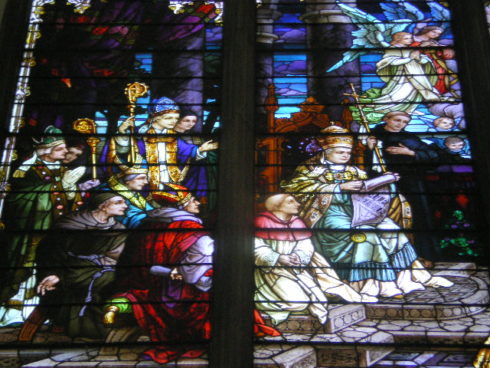By Plinio Corrêa de Oliveira
In 2004, the Church celebrated the 150th anniversary of the proclamation of the Dogma of the Immaculate Conception which affirmed that Mary was conceived without Original Sin. (Ed. American TFP)
 For centuries, the Immaculate Conception of Our Lady was defended by saints, theologians and laymen. However, it took centuries of theological debate to establish a consensus in the Church. Only in 1854, did Blessed Pope Pius IX, after consulting with the bishops of the whole world, proclaim this dogma in his Apostolic Constitution Ineffabilis Deus, thus affirming as revealed truth that Our Lady was preserved from Original Sin from the very moment of her conception.
For centuries, the Immaculate Conception of Our Lady was defended by saints, theologians and laymen. However, it took centuries of theological debate to establish a consensus in the Church. Only in 1854, did Blessed Pope Pius IX, after consulting with the bishops of the whole world, proclaim this dogma in his Apostolic Constitution Ineffabilis Deus, thus affirming as revealed truth that Our Lady was preserved from Original Sin from the very moment of her conception.
Many defended this position because they felt that the glory of the Most Holy Trinity would be tarnished if the Mother of the Word Incarnate were not the most perfect of all creatures. It would also be against God’s wisdom and mercy if the Savior’s mother did not receive the highest transcendental gifts of nature and grace.
The Immaculate Conception and America
The Immaculate Conception is particularly significant for Americans.
Americans join with Catholics the world over in celebrating the feast of the Immaculate Conception on December 8. They are filled with joy this year which marks the 150th anniversary of the proclamation.

Close up of a stained glass window depicting the formal proclamation by Pius IX of the doctrine of the Immaculate Conception in 1854.
However, this feast is especially dear to Americans because Our Lady of the Immaculate Conception is the nation’s patroness. Even before the proclamation of the dogma, the American bishops collectively placed the nation under the protection of the Immaculate Conception at the first Council of Baltimore in 1846. The pope ratified this decision on February 7, 1847.
The special place of Our Lady under this invocation led Theodore Cardinal McCarrick, Archbishop of Washington to ask the Holy See to grant a plenary indulgence for those who visit the Basilica of the Immaculate Conception in the nation’s capital for the year ending on December 8, 2004.
Reconciling Christ’s Universal Redemption
Although the Immaculate Conception can be found in Revelation and is part of the Deposit of Faith, it is not expressed with all the clarity of other truths like the Resurrection of Our Lord.
The main objection to the dogma revolved around the fact that, according to the dogma of Christ’s universal redemption, all men were redeemed from Original Sin by the merits of Our Lord Jesus Christ. However, if Our Lady was conceived without Original Sin, it would seem that she could not be redeemed from it by the merits of Christ.
How can these two assertions be reconciled? How does one explain the truth of the whole matter?
As Pius IX explains in his Apostolic Constitution Ineffabilis Deus, Mary Most Holy by the same merits of her Divine Son has been redeemed in a special, preventive manner, preserving her from Original Sin. As the Pope says, “the most Blessed Virgin Mary, Mother of God … her soul, in the first instant of its creation and in the first instant of the soul’s infusion into the body, was, by a special grace and privilege of God, in view of the merits of Jesus Christ, her Son and the Redeemer of the human race, preserved free from all stain of original sin. And in this sense have the faithful ever solemnized and celebrated the Feast of the Conception.”
While this simple formulation resolved the problem, it took several centuries to uncover. This is not surprising since the solution of delicate theological problems often takes a long time to resolve. Thus, in 1854, the Pope used the authority given him by Our Lord Jesus Christ to safeguard and infallibly interpret Revelation and defined the dogma once and for all.
Popular Piety Affirmed Dogma
Already in the fifth century, Saint Augustine affirmed that “piety imposed the recognition of Mary as not having sin.” (André Damino, Na escola de Maria, Ed. Paulinas, 1962, p. 39). Popular devotion took up this belief and the feast of the Immaculate Conception was already celebrated in the Oriental Catholic Church as early as the sixth century. Beginning in the eleventh century, theologians made detailed studies into the matter and verified the fact that popular devotion had grown. Popular enthusiasm for the feast increased so much that it was celebrated all over Europe in 1476.
To be Continued








